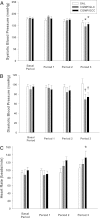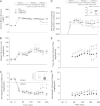A cyclic guanosine monophosphate-dependent pathway can regulate net hepatic glucose uptake in vivo
- PMID: 22688328
- PMCID: PMC3447895
- DOI: 10.2337/db11-1816
A cyclic guanosine monophosphate-dependent pathway can regulate net hepatic glucose uptake in vivo
Abstract
We previously showed that hepatic nitric oxide regulates net hepatic glucose uptake (NHGU), an effect that can be eliminated by inhibiting hepatic soluble guanylate cyclase (sGC), suggesting that the sGC pathway is involved in the regulation of NHGU. The aim of the current study was to determine whether hepatic cyclic guanosine monophosphate (cGMP) reduces NHGU. Studies were performed on conscious dogs with transhepatic catheters. A hyperglycemic-hyperinsulinemic clamp was established in the presence of portal vein glucose infusion. 8-Br-cGMP (50 µg/kg/min) was delivered intraportally, and either the glucose load to the liver (CGMP/GLC; n = 5) or the glucose concentration entering the liver (CGMP/GCC; n = 5) was clamped at 2× basal. In the control group, saline was given intraportally (SAL; n = 10), and the hepatic glucose concentration and load were doubled. 8-Br-cGMP increased portal blood flow, necessitating the two approaches to glucose clamping in the cGMP groups. NHGU (mg/kg/min) was 5.8 ± 0.5, 2.7 ± 0.5, and 4.8 ± 0.3, whereas the fractional extraction of glucose was 11.0 ± 1, 5.5 ± 1, and 8.5 ± 1% during the last hour of the study in SAL, CGMP/GLC, and CGMP/GCC, respectively. The reduction of NHGU in response to 8-Br-cGMP was associated with increased AMP-activated protein kinase phosphorylation. These data indicate that changes in liver cGMP can regulate NHGU under postprandial conditions.
Figures




Similar articles
-
A soluble guanylate cyclase-dependent mechanism is involved in the regulation of net hepatic glucose uptake by nitric oxide in vivo.Diabetes. 2010 Dec;59(12):2999-3007. doi: 10.2337/db10-0138. Epub 2010 Sep 7. Diabetes. 2010. PMID: 20823104 Free PMC article.
-
Portal vein caffeine infusion enhances net hepatic glucose uptake during a glucose load in conscious dogs.J Nutr. 2004 Nov;134(11):3042-6. doi: 10.1093/jn/134.11.3042. J Nutr. 2004. PMID: 15514273
-
Portal infusion of a selective serotonin reuptake inhibitor enhances hepatic glucose disposal in conscious dogs.Am J Physiol Endocrinol Metab. 2004 Dec;287(6):E1057-63. doi: 10.1152/ajpendo.00313.2004. Epub 2004 Aug 17. Am J Physiol Endocrinol Metab. 2004. PMID: 15315909
-
Regulation of hepatic glucose uptake and storage in vivo.Adv Nutr. 2012 May 1;3(3):286-94. doi: 10.3945/an.112.002089. Adv Nutr. 2012. PMID: 22585902 Free PMC article. Review.
-
Regulation of net hepatic glucose uptake in vivo.Annu Rev Physiol. 1992;54:847-60. doi: 10.1146/annurev.ph.54.030192.004215. Annu Rev Physiol. 1992. PMID: 1562194 Review.
Cited by
-
Hepatoselective Nitric Oxide (NO) Donors, V-PYRRO/NO and V-PROLI/NO, in Nonalcoholic Fatty Liver Disease: A Comparison of Antisteatotic Effects with the Biotransformation and Pharmacokinetics.Drug Metab Dispos. 2015 Jul;43(7):1028-36. doi: 10.1124/dmd.115.063388. Epub 2015 Apr 13. Drug Metab Dispos. 2015. PMID: 25870102 Free PMC article.
References
-
- An Z, DiCostanzo CA, Moore MC, et al. Effects of the nitric oxide donor SIN-1 on net hepatic glucose uptake in the conscious dog. Am J Physiol Endocrinol Metab 2008;294:E300–E306 - PubMed
-
- Denninger JW, Marletta MA. Guanylate cyclase and the. NO/cGMP signaling pathway. Biochim Biophys Acta 1999;1411:334–350 - PubMed
-
- Ming Z, Han C, Lautt WW. Nitric oxide inhibits norepinephrine-induced hepatic vascular responses but potentiates hepatic glucose output. Can J Physiol Pharmacol 2000;78:36–44 - PubMed
-
- Zhao Y, Brandish PE, DiValentin M, Schelvis JP, Babcock GT, Marletta MA. Inhibition of soluble guanylate cyclase by ODQ. Biochemistry 2000;39:10848–10854 - PubMed

